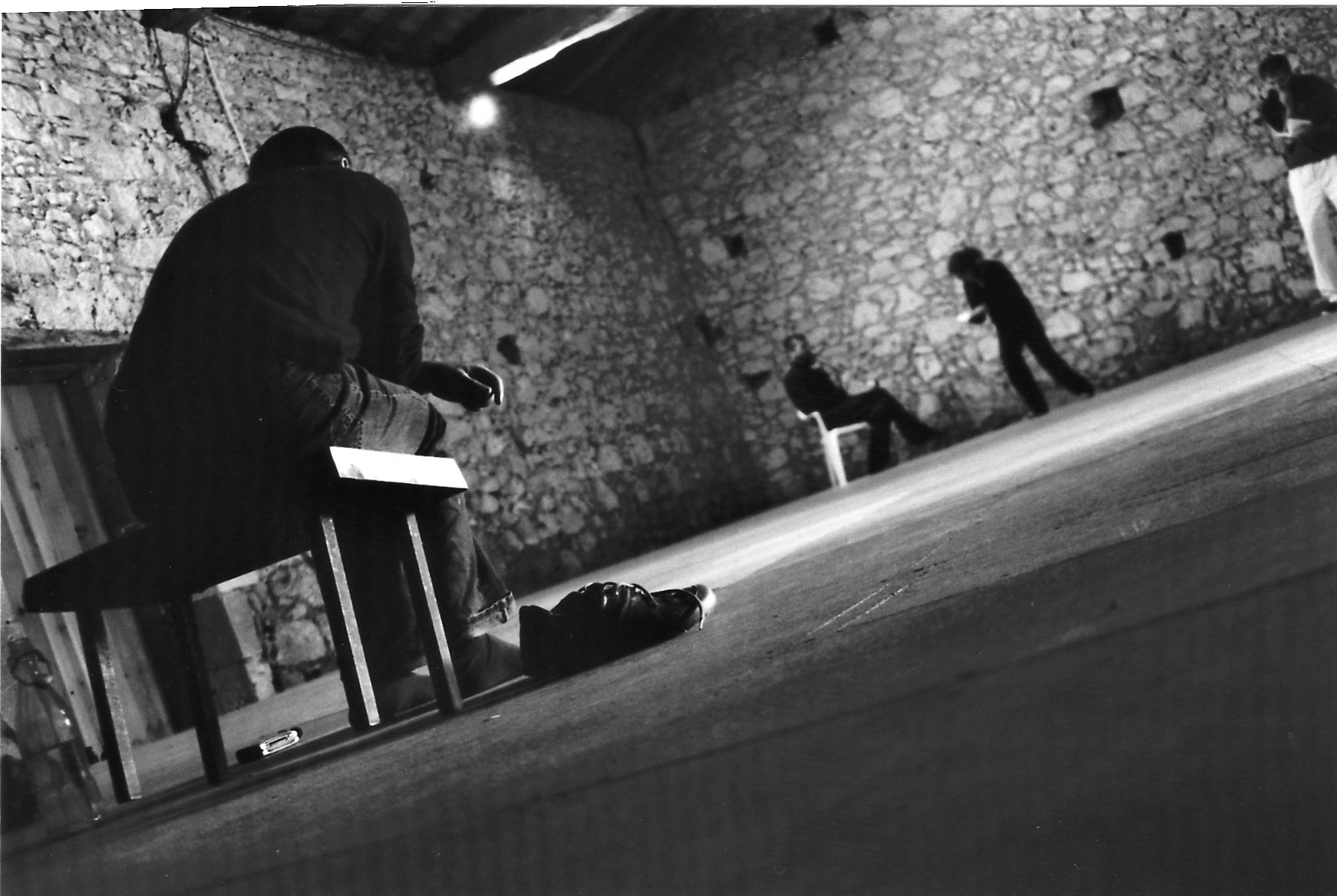The photograph above was taken seven years ago during an acting workshop I took part in in the southwest of France. The workshop consisted of a week of methodical theatrical experimentation with the text of Cervantes’ Don Quixote and it was one of the best acting experiences I’d ever had. The French director, seated, was in acting school with me and the three performers he was overseeing at the moment my shutter clicked were from France, Poland and Germany respectively.
I personally like the image because for me it captures something of a director’s omniscience, the outside eyes alert to the ebb and flow of what passes between the actors in front. When I look at the image I also see the solidarity and proximity of the actors contrasted with the director’s distance and isolation. Is there a suggestion of loneliness?
The perspective also exaggerates the director’s stature, dominating the frame like a giant waiting to smite the tiny humans before him. He is also a puppet-master and they his marionettes. Finally there is light and dark in the image and it is symbolic that the director sits mostly in darkness (and dark clothes) while there is an illusion that the actors are on the other side of the light that strikes the floor in the middle of the room. They are both separated and protected by it so they can be free to play.
Is it a beautiful image? Meh. That’s not really for me to say. I like it a lot because of what it symbolises to me. Namely, artistic endeavour. And there’s beauty in that. I also like the composition of the photo because it grabbed a moment of real concentration and seriousness in a creative space. And that is really beautiful. And from a completely personal point of view it reminds me of the great week that I had and the creative injection I got from doing good work with good people. I remember being grateful to my friend the director for the opportunity. I remember being exhilarated by the intense and uncompromising nature of the work. The shared bond of artistic frustration and hard-fought for breakthrough was very profound. Good creative experiences can be like that. And they are beautiful.
Don Quixote concerns itself with the adventures, illusions and delusions of an aged Spaniard who, inspired by his cherished tales of chivalrous knights of the Middle Ages, sets out on his own heroic crusade to right wrongs and uphold justice and hopefully rescue worthy and grateful maidens along the way. A man of honour and endless romance, he is a figure of ridicule, due both to the cynical attitudes of the times he lives in and also because he simply does not fit the bill. He is decrepit. Fusty, brittle and bony and accompanied by a short, fat farmer on a donkey. He is no knight in shining armour. He is not beautiful. But are his ideals? Is his vision? His fantasy? Is there a place that will recognise and respect the beauty of his noble delusion? You’ll have to read the book to find out.
It seems that we aren’t much interested in the beauty of ideas anymore. Human beauty is not something we think or feel, it is something we see. It is thrust upon us daily is this maddening age of vanity and hard sold lust. It is distortion and obsession sold to us as normality. Our cues are taken from the gender stereotypes as presented in popular media with the American movie and music industries being more culpable than most in their depictions of pneumatic sex-clone women and Barbie Doll men with sculpted but hairless physiques and all the nuance and emotional depth of a block of lard. And beauty has a sell-by date, just ask Renee Zellwegger who has recently reemerged after a 5-year hiatus looking radically different to her old self. She has been the subject of much discussion about the nature of her transformation and whether she should or shouldn’t have secretly morphed from moth to butterfly (or vice versa depending on your opinion) while no one was looking. I didn’t recognise her when I saw her photo but I thought “I hope you’re happy now, you must not have been before.” And I supposed it was done in the name of beauty.
There can be little doubt that women have it worse than men in this department. They are so endlessly and comprehensively objectified that all faith is lost in the idea of the beauty of imperfection. This is compounded by the widespread belief that men are interested only in this particular incarnation of a woman – over-sexed and under-dressed. It is an adolescent’s fantasy that has become the default mode for the alpha woman as imagined in Hollywood movies and music videos. What could be more normal than Nicky Minaj fellating a banana or the lovely Miley Cyrus writhing and riding on her big, swinging ball? Most recently we have the lead female character of David Fincher’s movie of Gillian Flynn’s novel, Gone Girl, being held up as the epitome of man’s darkest fear – the beautiful woman as succubus, stealer of souls, psychotic manipulator of truth and most damning of all, unafraid and independent.
Woman as witch. Deceiver. Shape-shifter (no! not that kind of shape-shifter, Renee!). I was thinking about this recently when I saw a woman who looked, well, a little witchy. There was an angularity of face and a pointiness of nose that immediately evoked the old archetype. I wondered why a witch was so demonised, so inherently evil. Is it because a witch is denied what men want most – her feminine sexuality? Her seductive and pliable beauty? And then I wondered if the phallic nature of a witch’s nose is the real symbol of male fear – the fear of being penetrated. Woman as witch is therefore woman as predator and woman as rapist. Whoa, Nelly. In Jung’s archetypes he refers to both woman as witch and woman as “terrible mother”, yet another dark opposite to a beauty ideal. We men want our women beautiful and docile and they must only be predators in ways and places of which we approve!
From a young age boys are encouraged to fetishise and respect things. Toys, bicycles, sports equipment, food, gadgets, technology and inevitably, the opposite sex. We’re set on the slippery slope early and often so it takes a particularly good pair of outdoor shoes not to get stuck in the mud with the rest of the wriggly worms. Girls on the other hand are encouraged to find their age-appropriate Don Quixote, their hero, their shining knight. Now even though you might argue that the image of a dashing knight lends itself to the objectification of men it seems that his spiffy good looks and svelte figure are secondary to what he really represents which is the idealised protector. The saviour and champion who will defend the girl’s honour against all slights. Girls therefore are taught to look for an ideal of beauty that is predicated on virtue and individuality. Paragons of chivalry, rescuing maidens from the dragon’s den. So boys and girls are moving in opposite directions right from the start.
Philosophers have disagreed on the nature of beauty, some arguing that things are inherently beautiful and others stating it can only ever be subjective. Whatever it is, it must be more than tautness of skin and pertness of breast. It must be more than shiny things or big things or expensive things. It must go far deeper than the superficial. It must be something that speaks to the soul and not just to the body. It must move rather than merely arouse. Beauty is in gesture, in action, in endeavour and in honesty. Why are we so reluctant to celebrate these modes of beauty?
You are so beautiful to me. What’s so beautiful to you?




nice one dara,i am with you on this one,i have been reading your clearouts but havent posted any comments till now,always enjoy them,x Sean
Thanks Seanie, I never presumed otherwise! Take her softly now.
Hi ya Dara,I’m still reciveing your clear outs, very good, enjoying your provocative thoughts from the outher end of the world,amazed how often they are seem relevant to me.
Shane Atlas
Great to hear from you Shane! How are the ears? Glad to have you on board. Hope life and music are treating you well.
D.